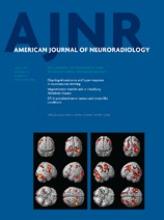Research ArticlePediatric Neuroimaging
Open Access
Location of Periventricular Nodular Heterotopia Is Related to the Malformation Phenotype on MRI
G. González, L. Vedolin, B. Barry, A. Poduri, C. Walsh and A.J. Barkovich
American Journal of Neuroradiology April 2013, 34 (4) 877-883; DOI: https://doi.org/10.3174/ajnr.A3312
G. González
aFrom the Department of Radiology and Biomedical Imaging (G.G., L.V., A.J.B.), University of California, San Francisco, California
bDepartment of Radiology (G.G.), Hospital San Juan de Dios, Santiago, Chile
L. Vedolin
aFrom the Department of Radiology and Biomedical Imaging (G.G., L.V., A.J.B.), University of California, San Francisco, California
cNeuroradiology Section (L.V.), Hospital Moinhos de Vento, Porto Alegre, Brazil
B. Barry
dDivision of Genetics (B.B., C.W.), Manton Center for Orphan Disease Research and Howard Hughes Medical Institute, Boston Children's Hospital, Boston, Massachusetts
A. Poduri
eDepartment of Neurology (A.P., C.W.), Boston Children's Hospital, Boston, Massachusetts
C. Walsh
dDivision of Genetics (B.B., C.W.), Manton Center for Orphan Disease Research and Howard Hughes Medical Institute, Boston Children's Hospital, Boston, Massachusetts
eDepartment of Neurology (A.P., C.W.), Boston Children's Hospital, Boston, Massachusetts
fDepartment of Neurology (C.W.), Harvard Medical School, Boston, Massachusetts.
A.J. Barkovich
aFrom the Department of Radiology and Biomedical Imaging (G.G., L.V., A.J.B.), University of California, San Francisco, California

References
- 1.↵
- Barkovich AJ,
- Guerrini R,
- Kuzniecky RI,
- et al
- 2.↵
- Guerrini R,
- Parrini E
- 3.↵
- Garbelli R,
- Rossini L,
- Moroni RF,
- et al
- 4.↵
- Sarkisian MR,
- Bartley CM,
- Rakic P
- 5.↵
- Ferland RJ,
- Batiz LF,
- Neal J,
- et al
- 6.↵
- 7.↵
- 8.↵
- Battaglia G,
- Franceschetti S,
- Chiapparini L,
- et al
- 9.↵
- 10.↵
- Leventer RJ,
- Guerrini R,
- Dobyns WB
- 11.↵
- Fox JW,
- Lamperti ED,
- Eksioglu YZ,
- et al
- 12.↵
- Sheen VL,
- Ganesh VS,
- Topcu M,
- et al
- 13.↵
- 14.↵
- 15.↵
- Barkovich AJ,
- Raybaud CA
- Barkovich AJ,
- Raybaud CA
- 16.↵
- Parrini E,
- Ramazzotti A,
- Dobyns WB,
- et al
- 17.↵
- Poussaint TY,
- Fox JW,
- Dobyns WB,
- et al
- 18.↵
- Guerrini R,
- Mei D,
- Sisodiya S,
- et al
- 19.↵
- Barkovich AJ,
- Raybaud CA
- Barkovich AJ,
- Mukherjee P
- 20.↵
- Hetts SW,
- Sherr EH,
- Chao S,
- et al
- 21.↵
- Kara S,
- Jissendi-Tchofo P,
- Barkovich AJ
- 22.↵
In this issue
Advertisement
G. González, L. Vedolin, B. Barry, A. Poduri, C. Walsh, A.J. Barkovich
Location of Periventricular Nodular Heterotopia Is Related to the Malformation Phenotype on MRI
American Journal of Neuroradiology Apr 2013, 34 (4) 877-883; DOI: 10.3174/ajnr.A3312
0 Responses
Jump to section
Related Articles
Cited By...
- Long-term Outcome of Epilepsy and Cortical Malformations Due to Abnormal Migration and Postmigrational Development: A Cohort Study
- Whole-brain multimodal MRI phenotyping of periventricular nodular heterotopia
- Agenesis of the corpus callosum with interhemispheric cyst: clinical implications and outcome
- Evaluation of Subependymal Gray Matter Heterotopias on Fetal MRI
- Malformations of Cortical Development and Epilepsy
This article has not yet been cited by articles in journals that are participating in Crossref Cited-by Linking.
More in this TOC Section
Similar Articles
Advertisement











